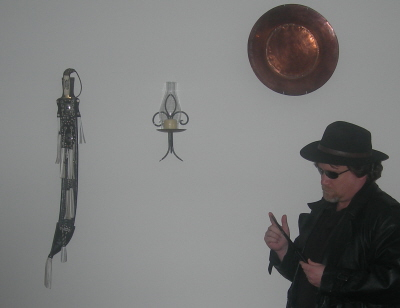|
About This Author
Come closer.
|
Complex Numbers
Complex Numbers
A complex number is expressed in the standard form a + bi, where a and b are real numbers and i is defined by i^2 = -1 (that is, i is the square root of -1). For example, 3 + 2i is a complex number.
The bi term is often referred to as an imaginary number (though this may be misleading, as it is no more "imaginary" than the symbolic abstractions we know as the "real" numbers). Thus, every complex number has a real part, a, and an imaginary part, bi.
Complex numbers are often represented on a graph known as the "complex plane," where the horizontal axis represents the infinity of real numbers, and the vertical axis represents the infinity of imaginary numbers. Thus, each complex number has a unique representation on the complex plane: some closer to real; others, more imaginary. If a = b, the number is equal parts real and imaginary.
Very simple transformations applied to numbers in the complex plane can lead to fractal structures of enormous intricacy and astonishing beauty.
October 23, 2020 at 12:01am October 23, 2020 at 12:01am
| |
This one's about mathematics, folks. I can already see your eyes glazing over.
Unlike yesterday's link, this one was written in proper American English, so it's "math," not "maths."
Here are some good mental math shortcuts to keep under your hat.
Does anyone (besides me) still wear hats?
To sign your check in record time:
To calculate the amount of a 20 percent tip, calculate 10 percent (or remove the last digit) and double it. For instance, with a $42.50 bill, 10 percent is $4.25 and double it to get an $8.50 tip.
This is so simple, straightforward, and obvious that I would have never thought to put it into an article about "secret math tips." I do it all the time. I do it when drunk. I don't just mean tipsy, I mean forget-the-Uber-call-an-ambulance brain-dead. Of course, at that point, I'm generally inclined to leave more than 20% and then forget my credit card. And my hat, and my glasses, and sometimes my pants. The tip is still easy for me, but I forget that not everyone considers simple mathematics "simple."
Complexity comes in, though, when you decide not to leave a 20% tip. Maybe the service was extra-slow, or the beer was warm, and you want to lower the tip to reflect that. Or, contrarily, maybe the bartender flirted with you and you want to leave something extra. Of course, you could leave your phone number as a tip, but that's generally considered gauche, and besides, unless you're Jeff Bezos, you don't have that much money.
Still easy, though. 15%? Move the decimal place once to the left, add the result to half of it. 30%? Move the decimal and multiply by three. 18%? Only if you're sober or if their machine hands you a handy tipping chart. Still, 18 is 20-2, so once you have 20%, move the decimal one more to the left and subtract the result.
To ace sale shopping:
First, remember that if you're offered a nominally $100 item for $70, you're not saving $30 but spending $70. But, assuming that you absolutely MUST have the item...
To find out how much you’ll pay for an item that’s a certain percentage off, first subtract the percent off from 100. So if it’s 30 percent off, use 70; 60 percent off, use 40, etc. Divide this number and the price by 10 and then multiply the resultant two numbers.
Still too much work for most people. I'd use the same trick with the tips: 10% is trivially easy, and then just multiply that by whatever. 3 if it's 70% off, 6 if it's 40% off, and so on.
To see your future without a crystal ball:
Use a time machine.
Okay, that's also out of reach for most people.
Use the rule of 72 to calculate how long it would take an investment to double. The rule of 72 is that an investment that earns 10 percent interest will double in 7.2 years.
Which is nice and all, but there are no viable 10% investments. Socking the money into a market-matching ETF will *probably* earn you an average of 8% over a long enough time frame (20 years or more), but that's smoothing out all of the ups and downs along the way and assuming that we won't be in a post-apocalyptic wasteland in 20 years. Any bond that promises to pay 10% annually is junk. Any guaranteed interest, say from a savings account, isn't going to net you more than 2% APY, and probably significantly less, these days.
Use this as a starting point for calculating various interest rates and lengths of time, by dividing the number 72 by your interest rate.
Which is a little more useful, but for a lot of people this is where they whip out their calculator, at which point you might as well use a Future Value equation, which is beyond the scope of this blog entry, but you can find it if you look.
Just don't forget that for an investment to double in terms of real spending power, you'd have to subtract the projected rate of inflation over the time period. Which is a guess.
To do fast house math:
To calculate how much a month more you’ll pay in a mortgage payment for a certain increase in house price, figure roughly 6 dollars per month for every thousand dollars more in total price.
This one, I wasn't familiar with. I haven't had any reason to use it. I've only purchased one house.
To translate temperatures when you travel:
Double it (Celsius) and add 30. Useful if you drive into Canada a lot. But then you also should know the miles/kilometers conversion, which I'll go into in a bit.
The actual conversion is C*9/5+32, but the quick one is good enough at most temperatures you'll encounter -- at least in the southern parts of Canada.
To be the fastest calculator in any room:
Multiply any number by four quickly by doubling the number twice. So 106 times four is 212 plus 212, for a total of 424.
As with the tip thing, I thought everyone did that.
To ease your wage wonders:
Double the hourly wage and add three zeros. $20 an hour is about $40K a year. $8 an hour is $16K annually. One of the first shortcuts I learned. As there are actually 52 weeks in a year, not 50, it'll be off by a bit, but who cares - taxes eat up way more than the error.
This assumes, of course, a standard 40 hour work week.
Another way to compare hourly wages to a salary is to drop the three zeros of a salary and then divide by two. So a salary of $42,000 would be roughly equivalent to $21 an hour.
Unless you work in one of the professions that requires salaried employees to work more than 40 hours a week which, last I checked, was all of them.
What the hell happened to computers allowing for greater productivity, leading to us working two days a week?
To analyze the impact of that coffee habit:
What coffee habit? Oh, fine, I suppose I can apply this to Crack Zero.
To estimate the annual cost of a daily habit, multiply to find the weekly total amount you spend (so, times 5 if it’s a weekday habit, or times 7 if it’s every day a week. Then add two zeros to that number, and divide by two.
Generally, when people do this, they get a nice fat kick in the assets.
To know how hard you have to study:
And this is where my own eyes glazed over. Been a while since I had to study, and all I ever did then was the best I could.
Even in math.
Okay, I said I'd talk about miles/kilometers conversion. This is not actually as bad as it seems at first glance. It's about 1.61 kilometers to a mile (the precise figure is 1.60934, but unless you're doing survey work, who cares?) Now, that's a tough number when you look at it, but one way to remember it is to consider the Golden Ratio.
The Golden Ratio, phi, is an irrational number that starts out 1.618033... and goes on to infinity, but again, who cares? The important thing about the GR is that if you subtract 1 from it, you get its multiplicative inverse, 1/phi: 0.618033... and that it's really remarkably close to the miles/kilometers conversion. This means that in addition to there being roughly 1.61 kilometers in a mile, there's 0.61 miles in every kilometer. Approximately. Good enough for driving.
And when you're actually driving, you don't even have to worry much about the 0.01 involved. 0.01 kilometers is, by defnition, 10 meters, which is about as accurate as most GPS receivers. So I just use 1.6 and 0.6.
As to how to do the conversion quickly, in your head, while driving and with no access to Google (which can give you a very accurate conversion at the risk of you crashing into someone), it's simple.
Take the number of kilometers on the road sign. Let's say Calgary is 30 kilometers away, for instance.
Divide by 2, which is the same as multiplying by 0.5. So, 15.
Add 1/10th of the original distance in km, which is 3, so 18.
Consequently, Calgary is about 18 miles away. The actual value, by Google, is 18.64. So the quick mental math can be improved upon, sure, but again... we're talking about driving, not surveying.
The reason the Golden Ratio comes into play is that reversing the calculation is very similar. Take the number of miles, add half, add 1/10th. So if something is 50 miles away, it's 50+25+5=80 km. Roughly. The actual value is closer to 80.5.
Either way, it's simpler than converting pounds to kilograms, which only works on the Earth's surface anyway and then only approximately, as pounds are a unit of force and kilograms are a unit of mass and gravity is measurably different at different points on the planet.
But the conversion factor is roughly 2.2 kilos per pound under those conditions, which, given the above, should be a dead easy conversion for you right now.
Now, go to England, where petrol is dispensed by the liter and priced in British pounds, and try to figure out how much a gallon of gas costs over there. Solution: a metric shit-ton. |
© Copyright 2025 Robert Waltz (UN: cathartes02 at Writing.Com). All rights reserved.
Robert Waltz has granted InkSpot.Com, its affiliates and its syndicates non-exclusive rights to display this work.
|

